ERS Charts of Note
Subscribe to get highlights from our current and past research, Monday through Friday, or see our privacy policy.
Get the latest charts via email, or on our mobile app for  and
and 
_450px.png?v=8085.9)
Monday, August 22, 2022
U.S. adults ages 20 and older reported a 3 percent higher prevalence of obesity during the first year of the Coronavirus (COVID-19) pandemic, according to a recent study conducted by a researcher at the USDA, Economic Research Service (ERS). The study analyzed data from the Centers for Disease Control and Prevention’s (CDC) Behavioral Risk Factor Surveillance System from March 13, 2020, to March 18, 2021, compared to a pre-pandemic baseline period of January 1, 2019, to March 12, 2020. Four behaviors that can influence the risk of obesity—exercise, hours of sleep, alcohol use, and cigarette smoking—were also examined to help explain the change in the adult obesity rate during the pandemic. Participation in exercise rose 4.4 percent over the period and people slept 1.5 percent longer, both associated with reducing obesity. Meanwhile, the number of days in the period of a month in which alcohol was consumed was 2.7 percent higher, and cigarette smoking dropped by 4 percent. Research shows that higher alcohol intake and reduced cigarette smoking can lead to obesity and therefore may have contributed to the higher rate of obesity among U.S. adults during the pandemic. This chart appears in the ERS’s Amber Waves article, "Adult Obesity Prevalence Increased During the First Year of the COVID-19 Pandemic", published July 2022.
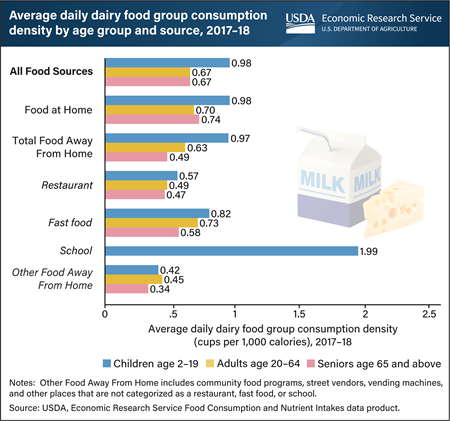
Tuesday, June 7, 2022
From 2017 to 2018, meals, snacks and other foods at school were the richest source of dairy for children ages 2 to 19. These foods provided an average of 1.99 cups of dairy products per 1,000 calories consumed each day. The USDA, Economic Research Service’s (ERS) Food Consumption and Nutrient Intakes data product provides calculations of the average daily consumption of food groups and selected nutrients by food sources. It uses food consumption data collected from a nationally representative sample of U.S. consumers by the USDA and the Department of Health and Human Services. Food sources are comprised of foods prepared at home and foods prepared away from home, including foods from restaurants, fast food establishments, and schools. The dairy foods group, as defined by USDA dietary guidance, is a major source of calcium and includes milk, cheese, yogurt, lactose-free milk, and fortified soy milk. The Dietary Guidelines for Americans, 2020–25, recommend individuals 2 years and older should consume 2–3 cups of dairy per day, depending on age and calorie level of dietary pattern. Although no age group meets this recommendation, children come the closest, with school foods making an important contribution. This chart was drawn from the ERS’s Amber Waves article, “Food Consumption and Nutrient Intakes Data Product Shines a Light on U.S. Diets”, September 2021.
_450px.png?v=8085.9)
Tuesday, May 31, 2022
While overall U.S. dairy consumption remained flat from 1979 to 2019, daily cheese consumption more than doubled, according to loss-adjusted food availability data from the USDA, Economic Research Service (ERS), which adjusts the amount of basic commodities available in the food supply for food spoilage, plate waste, and other losses to more closely approximate actual consumption. Overall U.S. dairy consumption remained roughly the same over this 40-year period, at just under 1.5 cup-equivalents of dairy products per person per day. However, daily cheese consumption grew to 0.72 cup-equivalents per person in 2019 from 0.34 cup-equivalents per person in 1979. Yogurt consumption grew almost fivefold to 0.05 cup-equivalents per person. Fluid milk consumption stood at 0.5 cup-equivalents per person in 2019, down from 0.9 cup-equivalents per person in 1979. Several factors contributed to this decline, including competition from alternative beverages, an aging population with differing preferences across generations, and changing consumer attitudes regarding milk fats. This chart is from ERS’s Ag and Food Statistics: Charting the Essentials, updated April 2021.
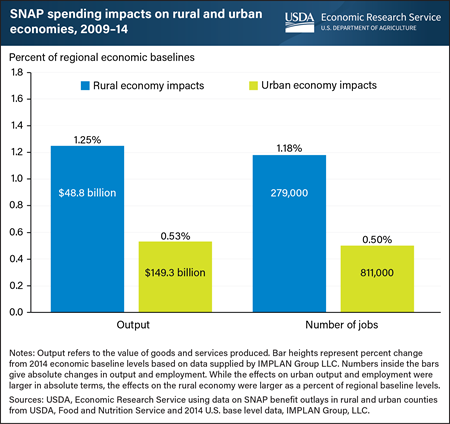
Tuesday, February 15, 2022
USDA’s Supplemental Nutrition Assistance Program (SNAP) provides low-income U.S. households assistance to buy food items, which helps to support the economy during periods of high unemployment. Researchers at USDA’s Economic Research Service (ERS) studied the effect SNAP benefits had on the rural and urban economies during the period of high unemployment following the Great Recession from 2009–14. They found household spending of SNAP benefits contributed disproportionately more to the rural economy. SNAP benefits can only be used on food items—farm goods (such as fruits, vegetables, and milk) and processed foods (such as breads and pastas)—but using them frees up money to spend on other nonfood items. ERS researchers found SNAP benefit spending caused a ripple effect that helped to support local jobs and contributed to economic output through the production of goods and services. During the 6-year period, average annual SNAP benefit expenditures of $71 billion (in 2014 dollars) generated an annual increase in rural economic output of $49 billion and an urban output of $149 billion. Expenditures supported the employment of 279,000 rural workers and 811,000 urban workers. When measured in total dollars and numbers of jobs, household spending of SNAP benefits generated larger economic impacts in the urban economy. However, when measured as a share of total economic output and employment, SNAP generated larger relative impacts in the rural economy. Household expenditures of SNAP benefits increased rural economic output annually by 1.25 percent and rural employment by 1.18 percent. For the urban economy, SNAP benefits increased economic output by 0.53 percent and employment by 0.50 percent. This chart appears in the Amber Waves finding USDA’s Supplemental Nutrition Assistance Program (SNAP) Contributed to Rural Economic Output, Jobs Following the Great Recession, released December 7, 2021.
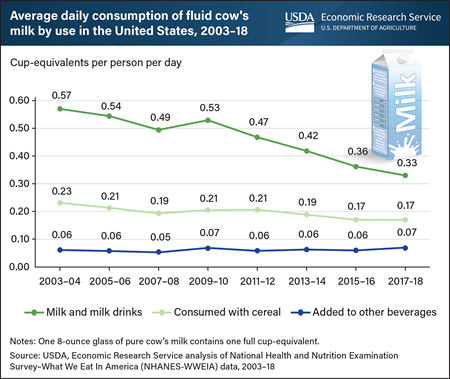
Monday, January 31, 2022
U.S. per capita consumption of fluid cow’s milk has been trending downward since about the mid-1940s, and it fell at a faster rate during the 2010s than in each of the previous six decades. Using dietary intake surveys collected between 2003 and 2018, USDA, Economic Research Service (ERS) researchers examined recent trends in milk consumption by looking at how individuals consumed the milk and consumers’ ages. Results confirmed that drinking milk as a beverage is the primary way that individuals of all ages consume fluid cow’s milk. These beverages include plain and flavored fluid milk as well as malted milk, eggnog, kefir, hot chocolate, and other milk-based beverages. On a given day in 2003–04, U.S. consumers drank about 0.57 cup-equivalents of fluid cow’s milk on average. Per person consumption of milk as a beverage fluctuated over the 2000s between 0.53 and 0.57 cup-equivalents per day. However, it declined over the 2010s, falling to 0.33 cup-equivalents in 2017–18. Over the study period, U.S. per person consumption of milk with cereal also fell by 0.06 cup-equivalents, with the steepest drop in consumption occurring among children. No significant changes were detected in the amount of milk that U.S. consumers pour into other, non-dairy beverages such as tea and coffee. This chart appears in the ERS report Examining the Decline in U.S. Per Capita Consumption of Fluid Cow’s Milk, 2003–18, released October 2021.
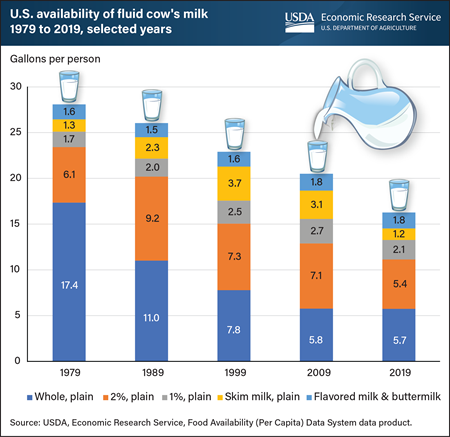
Monday, January 10, 2022
The supply of fluid cow’s milk available for U.S. consumers to drink decreased by 42 percent from 1979 to 2019, from 28.1 gallons per person to 16.3 gallons, according to USDA, Economic Research Service (ERS) food availability data. Whole milk availability drove this decline, falling nearly 67 percent to 5.7 gallons per person in 2019 from 17.4 gallons in 1979. The amount of low-fat, skim, and 1 percent milk available for U.S. consumption grew slightly over the last 40 years to a combined 3.3 gallons per person in 2019 from 3.0 gallons in 1979. Availability of 2 percent milk initially grew from 6.1 gallons per person in 1979 to a high of 9.2 gallons in 1989 before falling to 5.4 gallons in 2019. Whole milk was replaced by 2 percent milk as the most consumed milk type in 2005. Availability of flavored milk and buttermilk remained relatively steady over the last four decades, totaling 1.8 gallons per person in 2019. Several factors affect trends in U.S. per person milk availability, including competition from alternative beverages, an aging population, and changing consumer attitudes and preferences regarding milk fats. The data for this chart come from the ERS Food Availability (Per Capita) Data System.
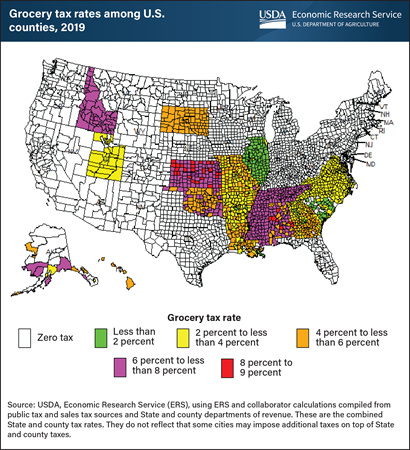
Friday, November 5, 2021
Foods purchased at grocery stores, supercenters, and other retail venues were exempt from sales taxes in 57 percent of U.S. counties in 2019. The remaining counties taxed food purchases at various levels across 18 states, mostly in the Southeast and Midwest. Alabama’s Tuscaloosa and Cullman counties had the highest grocery tax rate at 9 percent (4 percent State plus 5 percent county). Grocery tax rates not only vary across different States, counties, and cities, but they can also change over time. Using county-level tax data in combination with the USDA’s National Household Food Acquisition and Purchase Survey (FoodAPS), researchers at USDA, Economic Research Service (ERS) recently examined whether grocery taxes are associated with how much money U.S. households spend for food at retail outlets and restaurants. ERS found that grocery taxes were associated with differences in food spending among lower-income households that were eligible for the Supplemental Nutrition Assistance Program (SNAP) but did not participate in it. Among those households, researchers were able to associate taxes on groceries with reduced food spending at retail stores and increased food spending at restaurants. However, Federal law and USDA regulations stipulate that foods purchased with SNAP benefits are exempt from State and local sales taxes, and no such relationship was found among households participating in SNAP. This chart is drawn from the ERS report Food Taxes and Their Impacts on Food Spending, released September 2021.
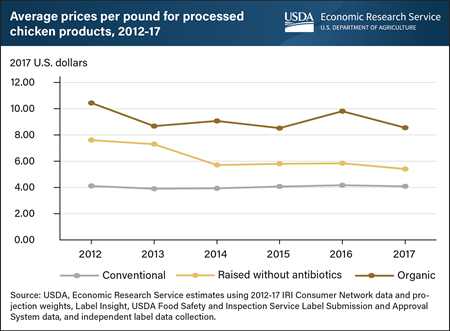
Friday, September 24, 2021
Processed chicken products whose labels show they were raised without antibiotics (RWA) were on average $2.23 per pound more expensive than conventional chicken products between 2012 and 2017, representing a 55-percent markup over conventional products. Processed chicken products include fresh or frozen chicken products that are cooked, marinated, breaded, or fried. A recent USDA, Economic Research Service (ERS) report shows consumer awareness of antibiotic use in meat and poultry production has increased over the past decade, and a growing market has emerged for chicken products that carry an RWA label. Though raising animals without antibiotics can be costly, producers can benefit from doing so when consumers are willing to pay higher prices for RWA products. Analyzing national household scanner data and a constructed dataset of chicken product labels, ERS researchers also found prices for organic processed chicken products were higher than those with RWA labels. From 2012 to 2017, prices for organic processed chicken products were on average $5.13 a pound more than conventional chicken products, representing a 125-percent total markup. These price differences suggest there are significant market opportunities for production practices that fall somewhere between conventional and the standards required for organic production. This information is drawn from the ERS report, The Market for Chicken Raised without Antibiotics, 2012-17, released September 2021.
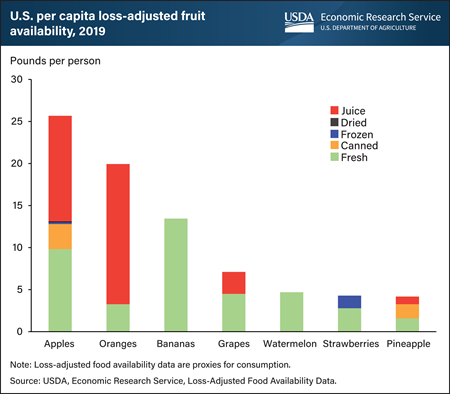
Monday, August 30, 2021
Apples held the top spot for total fruit available for consumption in 2019 at more than 25 pounds per person after adjusting for losses. The USDA, Economic Research Service’s (ERS) loss-adjusted food availability data are derived from food availability data by adjusting for food spoilage, plate waste, and other losses to more closely approximate actual consumption. According to recently released estimates, people in the United States consumed an average of 12.6 pounds (equivalent to 1.4 gallons) of apple juice, roughly 10 pounds of fresh apples, and a total of 3.3 pounds of canned, dried, and frozen apples in 2019. Among the top seven consumed fruits in 2019, apples were the only fruit available in all five forms: fresh, canned, frozen, dried, and juice. Pineapples were the only other canned option among these seven fruits, while strawberries were the only other frozen fruit available. Bananas (13.4 pounds per person) topped the list of most popular fresh fruits, while orange juice (16.7 pounds or 1.9 gallons) remained America’s favorite fruit juice. The data for this chart come from the Loss-Adjusted Food Availability data series in the ERS Food Availability (Per Capita) Data System, updated July 21, 2021.
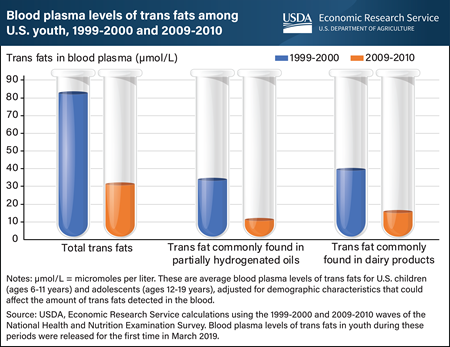
Monday, July 19, 2021
A 2020 USDA, Economic Research Service (ERS) study analyzed data publicly released for the first time in March 2019 and found that blood plasma levels of trans fats among youth fell by more than three-fifths (61.9 percent) from 1999-2000 to 2009-2010. Trans fats raise artery-clogging “bad” cholesterol (low-density lipoprotein, or LDL) levels and lower “good” cholesterol (high-density lipoprotein, or HDL) levels. Thus, increased intake of trans fats can result in an elevated risk of cardiovascular disease. The decrease in blood plasma levels of trans fats among youth came after a recommendation in the 2005 Dietary Guidelines for Americans to limit consumption of trans fats and a Federal Government requirement that trans fats content be included on packaged food labels. While young people are at a lower risk of developing cardiovascular disease than adults, intake of trans fats in early childhood and adolescence could set in motion processes that lead to the disease in adulthood. Data on blood plasma levels of trans fats of children (ages 6-11 years) and adolescents (ages 12-19 years) living in the United States were drawn from the 1999-2000 and 2009-2010 waves of the National Health and Nutrition Examination Survey, a nationally representative survey that assesses the health and nutritional status of the U.S. population. Blood plasma levels of the type of trans fat often found in partially hydrogenated oils fell by about two-thirds (67.2 percent) from 1999-2000 to 2009-2010, compared with a 60.5 percent decline in blood plasma levels of the type often found in dairy products. This chart appears in the ERS’ Amber Waves article, Trans Fat Levels Among U.S. Youth Fell From 1999 to 2010, June 2021. See also an Amber Waves finding from June 2017, Blood Levels of Trans Fats Among American Adults Fell from 1999 to 2010.
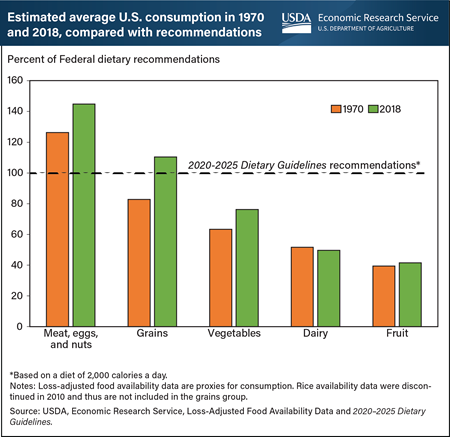
Friday, June 4, 2021
Although people in the United States are eating more vegetables and fruit than they did in 1970, the average U.S. diet still falls short of Federal recommendations for these two major food groups, as well as for dairy, as provided in the 2020-2025 Dietary Guidelines for Americans. In contrast to the recommended daily 2.5 cups of vegetables on a 2,000-calorie-per-day diet, people in the United States consumed an average of 1.9 cups in 2018, according to food availability data from the USDA, Economic Research Service (ERS). This represents 76 percent of the recommended amount, up from 63 percent in 1970. In 2018, U.S. consumers ate or drank an average of 1.5 cups of dairy products per day—50 percent of the recommended 3 cups and a decrease from 1.6 cups in 1970. Fruit consumption in the United States was the farthest below guidance at 41 percent of the recommended 2 cups. On average, U.S. consumption of foods in the meat, eggs, and nuts category and of grains in 2018 exceeded recommended amounts. The data for this chart come from the Loss-Adjusted Food Availability data series in ERS's Food Availability (Per Capita) Data System.
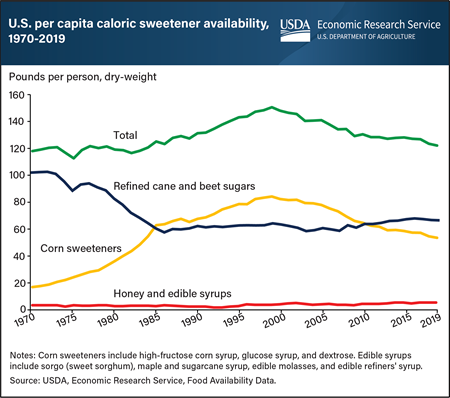
Monday, May 3, 2021
In 2019, 123.2 pounds per person of caloric sweeteners were available for consumption by U.S. consumers, a 19 percent decrease from a high of 151.5 pounds per person in 1999. According to the USDA, Economic Research Service’s (ERS) Food Availability (Per Capita) Data System, availability of total corn sweeteners (high-fructose corn syrup, glucose syrup, and dextrose) contributed to the drop, falling from its peak of 83.6 pounds per person in 1999 to 52.7 pounds per person in 2019. High corn prices, price competition with refined cane and beet sugars and other caloric sweeteners, as well as shifting preferences among consumers and food manufacturers have contributed to this decline. Availability of refined cane and beet sugars fell from 102.3 pounds per person in 1972 to 60.0 pounds per person in 1986, then remained relatively flat for the next two and a half decades. Refined sugar availability began to rise in 2010, surpassing corn sweetener availability and reaching 68.4 pounds per person in 2019. Rising honey imports have contributed to recent increases in per capita honey availability, according to ERS’s Sugars and Sweeteners Yearbook Tables. In 2019, per capita honey availability stood at 1.3 pounds and per capita availability of edible syrups was 0.8 pounds. This chart is from ERS’s Ag and Food Statistics: Charting the Essentials data product, updated January 14, 2021.
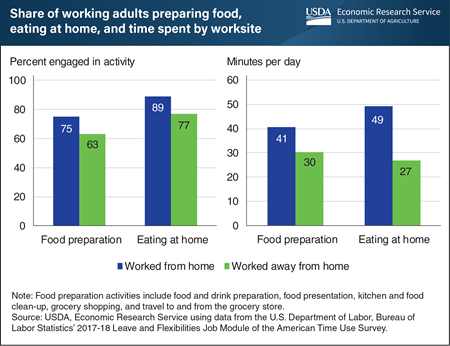
Wednesday, March 3, 2021
The U.S. Federal Government announced social distancing guidelines in March 2020 to slow the spread of COVID-19, and many U.S. jurisdictions followed by issuing stay-at-home orders. As a result, many people have been working from home since then, which prompts the question: Do individuals who work from home spend time on their daily tasks differently than those who work away from home? While USDA, Economic Research Service (ERS) researchers do not have time-use data from the COVID-19 period for the United States, analyses of past time-use patterns provide some insights. ERS researchers used data from the 2017-18 Leave and Flexibilities Job Module of the Bureau of Labor Statistics’ American Time Use Survey to study the amount of time respondents spent in food preparation and eating at home, according to the location from which they worked the day covered by the interview. They found that over an average weekday in 2017-18, prime working-age adults who worked from home were more likely to prepare food (75 percent versus 63 percent) and to spend more time doing so (41 minutes compared with 30 minutes) than individuals who worked away from home. Individuals who worked from home spent 49 minutes eating at home, which was nearly double the amount reported by individuals who worked away from home (27 minutes). Teleworkers may consume a healthier diet if the greater time spent preparing food translates into eating more home-prepared meals and less eating out. Home-prepared meals tend to be lower in calories and higher in positive nutrients than meals prepared away from home, according to studies by ERS researchers. This chart appears in the ERS’ Amber Waves article, “Working From Home Leads to More Time Spent Preparing Food, Eating at Home,” February 2021.
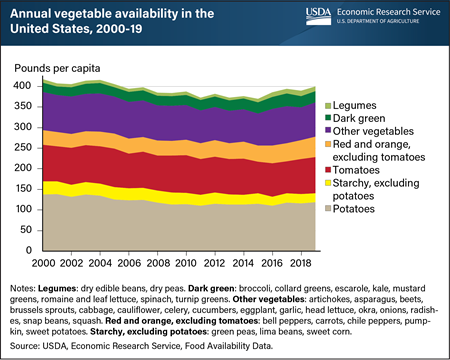
Monday, February 22, 2021
People in the United States are slowly expanding the variety of vegetables on their plates, data from the USDA, Economic Research Service (ERS) show. The vegetables food group is composed of five main subgroups: legumes, dark green, other vegetables, red and orange (including tomatoes), and starchy (including potatoes). Each offers an array of important vitamins, minerals, and dietary fiber. From 2000 to 2019, the combined share of dark green vegetables, red and orange vegetables (excluding tomatoes), and legumes available to eat in the United States increased from 16 percent to 22 percent. Increased availability of dark green vegetables over this period—led by a 47-percent jump in romaine and leaf lettuce—added additional variety for U.S. consumers. While the overall amount of vegetables available over the last two decades has decreased 4 percent, from 417.4 pounds per capita in 2000 to 400.1 pounds in 2019, there has been an increase in availability in recent years due in part to the expansion in varieties available for consumption. ERS’s Food Availability (Per Capita) Data System provides annual estimates of the per-capita availability for more than 200 food commodities consumed in the United States. This chart appears in the ERS Amber Waves article, “U.S. Supplies of Vegetables Available To Eat in 2019 Down Slightly From 2000, But Variety Has Grown,” February 2021.
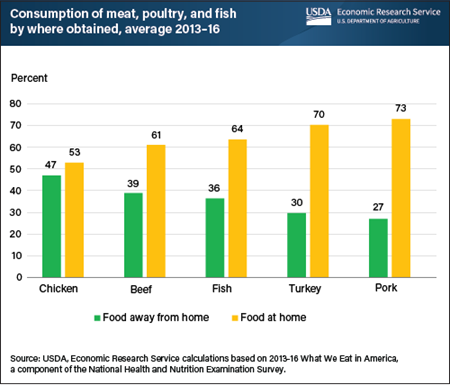
Tuesday, February 2, 2021
In light of shifts in eating habits due to COVID-19, USDA, Economic Research Service (ERS) researchers recently analyzed national survey data on foods eaten and where they were acquired. Data show that in the United States during 2013-16, almost half the chicken consumed was obtained at restaurants and other eating places away from home. ERS researchers looked at the most recent data available, from the National Health and Nutrition Examination Surveys conducted during 2013-16. They estimated the consumption of 63 commodities by two food sources: food at home (foods obtained at grocery stores, supercenters, and other retailers) and food away from home (foods obtained at away-from-home eating places). Among meat, poultry, and fish during 2013-16, the food most eaten at restaurants and other eating places away from home was chicken (47 percent). This was followed by beef (39 percent) and fish (36 percent). Pork had the lowest away-from-home share (27 percent), behind turkey (30 percent). Results from the ERS analysis indicate that when people in the United States consume more of their food at home because of the pandemic, consumption of specific commodities may be affected differently because people tend to eat a different mix of foods at home. This chart is based on a chart in the ERS COVID-19 Working Paper, Shares of Commodity Consumption at Home, Restaurants, Fast Food Places, Schools, and Other Away from Home Places: 2013-16, released December 2020.
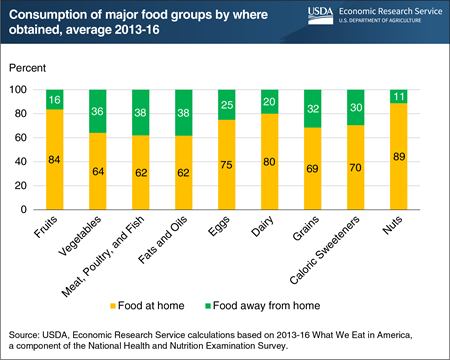
Wednesday, January 27, 2021
As COVID-19 disrupted life at home, work and school in 2020, U.S. consumers shifted where they obtained their food. For many people, grocery store foods replaced meals and snacks previously eaten in restaurants, college dining halls, sports venues, and other eating-out places. To better gauge the potential effect on commodity sectors due to changes in access to commercial eating places, Economic Research Service (ERS) researchers recently studied national survey data on foods eaten and where they were acquired. ERS researchers used recent 2013-16 data from the National Health and Nutrition Examination Survey to estimate the consumption of 63 commodities by two food sources: food at home (foods obtained at grocery stores, supercenters, and other retailers) and food away from home (foods obtained at away-from-home eating places). Their analysis shows that consumers obtained 38 percent of their meat, poultry and fish at restaurants and other eating places away from home during 2013-16. The fats and oils food group showed the same share. On the other end of the data, the share of nuts obtained at eating-out establishments was 11 percent, as most consumers bought that product from stores. For the same period, consumers obtained a larger share of vegetables (36 percent) away from home compared with fruits (16 percent). As people in the United States consume more of their food at home because of the pandemic, consumption of specific commodities may be affected differently. This chart appears in the ERS COVID-19 Working Paper, Shares of Commodity Consumption at Home, Restaurants, Fast Food Places, Schools, and Other Away from Home Places: 2013-16, released December 2020.
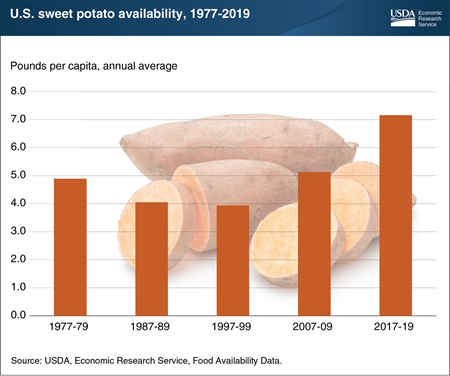
Tuesday, November 24, 2020
If sweet potatoes are on your Thanksgiving menu this year, you are not alone. According to the Economic Research Service’s (ERS) food availability data, supplies of sweet potatoes available for U.S. consumers to eat averaged 7.2 pounds per capita per year in 2017-19, up from an average 3.9 pounds in 1997-99. Availability is calculated by adding domestic production, initial inventories, and imports, then subtracting exports and end-of-year inventories. These national supplies are then divided by the U.S. population to estimate per capita availability. Consumer interest in nutrition and food companies expanding their sweet potato-based offerings, such as sweet potato fries, may be contributors to the rise in sweet potato availability. Sweet potatoes are high in vitamin A and vitamin C. A cup of boiled sweet potatoes without the skin (and without any added fats or marshmallow toppings) contains 249 calories and 287 percent of the daily recommended amount of vitamin A, 47 percent of vitamin C, and 29 percent of dietary fiber for a 2,000 calories-per-day diet. This chart uses data from ERS’s Food Availability (Per Capita) Data System.
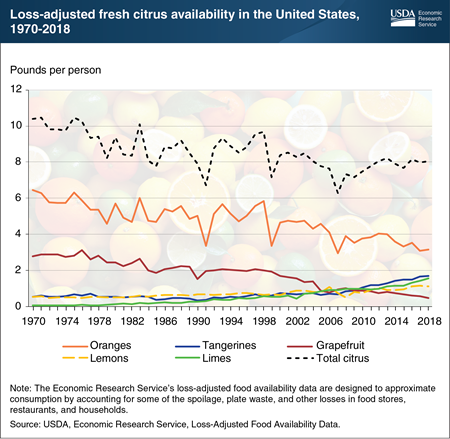
Friday, September 4, 2020
In 2018, the total supply of fresh citrus fruits available for Americans to eat—after adjusting for spoilage, plate waste, and other losses in food stores, restaurants, and households—was 8.0 pounds per person. From 1970 to 2018, loss-adjusted per person availability of oranges and grapefruit fell by 51 and 84 percent, respectively, while availability of other citrus fruits grew—lemons, for example, doubled; limes increased by 22 times. Year-to-year changes in availability of citrus fruits reflect production swings due to weather events, citrus diseases, changes in import or export volumes, and other factors. Longer term trends, however, are usually driven by changes in consumer demand. For example, skipping breakfast—or making it a “grab and go” meal—is likely to reduce demand for fresh oranges and grapefruit. Grapefruit takes more effort to eat, especially when compared with easy-to-peel citrus fruits such as tangerines that are sweet in taste and smaller in size. The popularity of Hispanic, Asian, and other cuisines that use lemons and limes could be contributing to higher demand for these fruits. This chart appears in ERS’s Amber Waves article, “Citrus Fruits Accounted for 14 Percent of Fresh Fruits Available for Americans to Eat in 2018,” August 2020.
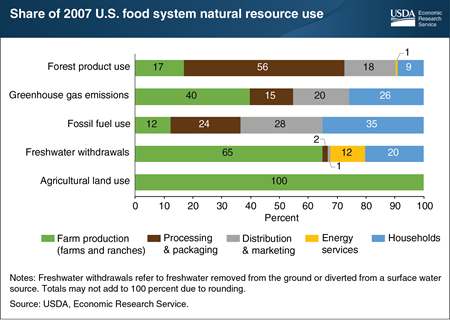
Wednesday, August 12, 2020
Knowing where natural resource use accumulates is fundamental to understanding what factors influence resource-use decisions. A recent Economic Research Service (ERS) study estimated natural resource use by the U.S. food system in 2007 (2007 data were the latest available with the level of detail needed for the analysis). Farm production was the smallest user of fossil fuels (12 percent of fossil fuel use); households were the largest users (35 percent). Over 40 percent of greenhouse gas emissions in food production were from farms and ranches, followed by households, and then companies that distribute and market food. For forest products, the greatest use occurred during food processing and packaging, with paper-based packaging accounting for most of this use. Farm production was the dominant user of freshwater withdrawals due to irrigation, but slightly over a third of water use by the food system in 2007 occurred after the farm, including in household kitchens (20 percent) and in the energy industry (12 percent). This chart appears in the ERS report, Resource Requirements of Food Demand in the United States, and Amber Waves article, “A Shift to Healthier Diets Likely To Affect Use of Natural Resources,” May 2020.
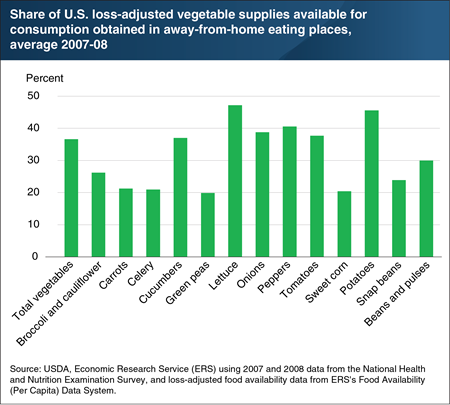
Wednesday, June 17, 2020
COVID-19-related stay-at-home orders have shifted the places where consumers obtain a large share of their meals and snacks. Foods bought in grocery stores have replaced meals and snacks previously eaten in restaurants, college dining halls, school cafeterias, sports venues, and other eating-out places. Results from a 2016 Economic Research Service (ERS) study indicate this shift in where Americans obtain their foods is likely to affect the marketing and consumption of specific vegetables differently, depending on what share of a vegetable’s total consumption is obtained in away-from-home eating places and whether that share has changed over the last decade. In 2007-08 (the latest food-intake survey used in the 2016 study), Americans obtained 36.6 percent of their vegetables away from home. Lettuce and potatoes had the highest away-from-home shares at 47.2 and 45.6 percent, respectively. Green peas and sweet corn had the lowest away-from-home shares of the vegetables examined—just 20 percent of these vegetables were obtained at away-from-home eating places in 2007-08. ERS researchers used national survey data on foods eaten and where they were acquired to disaggregate 63 commodities in ERS’s Loss-Adjusted Food Availability data system into two broad categories: food at home (foods obtained at grocery stores, supercenters, and other retailers) and food away from home (foods obtained at away-from-home eating places). ERS’s loss-adjusted food availability data take per capita supplies of food commodities in all forms—fresh, canned, frozen, and dried—available for human consumption. The data adjust for some of the spoilage, plate waste, and other losses in grocery stores, restaurants, and homes. The data in this chart appear in the 2016 ERS report, U.S. Food Commodity Availability by Food Source, 1994-2008.


